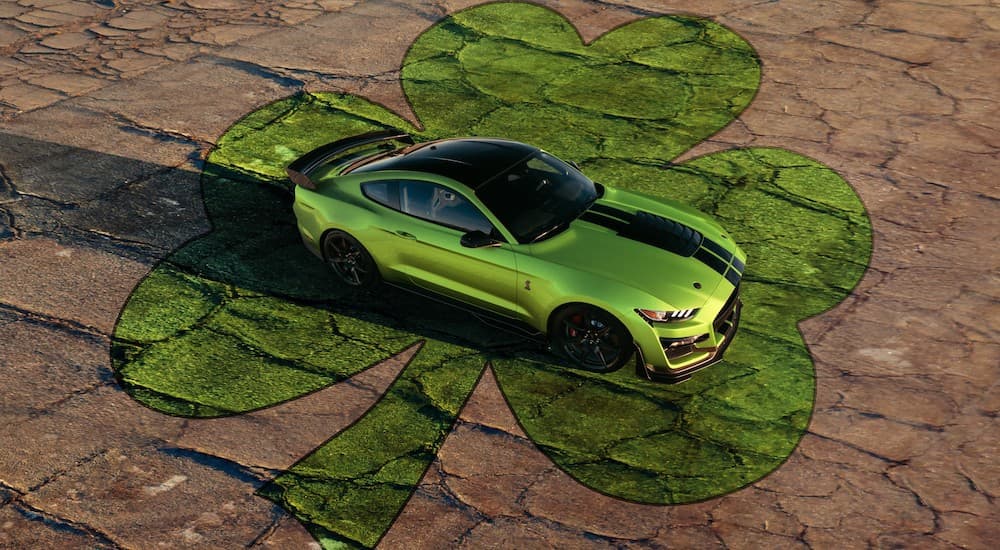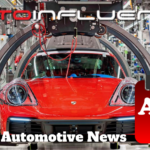Here we are back again with Auto Influence in this week’s round of automotive news expanded to cover some of the other highlights from the month of March.
FORD
Twitter wars are nothing new, even within the automotive landscape. But if there have been any pairings of warring automakers who have proven most interesting to their respective followings, Ford and Tesla might rank near to the top. Last summer we had Elon Musk boasting Tesla’s production of 7000 cars in 7 day, only to be answered by Ford’s Steven Armstrong praising his time for production of 7000 cars in 4 hours. But it was this month’s exchange that might most resemble trolling when – immediately following Tesla’s scheduled unveiling of their highly-anticipated, all-electric Model Y crossover – Ford tweeted “Hold your horses” with a non-contextual teaser image of their all-electric Mustang-inspired crossover. Ford’s enigmatic project, first announced at the 2018 NAIAS has been the target of endless speculation – and to ride that momentum in epic troll fashion offered more than a few chuckles. And based on Elon Musk and Tesla’s appreciation of a strong social media game, we’re sure they appreciated the humor present in the attempt.
Segueing over to the Mustang, Ford used the St. Patrick’s Day holiday to announce that the upcoming Shelby GT500 would gain another boost in the inclusion of bold new colors, including the delightfully obnoxious ‘Grabber Lime’. Recalling a similar offering from the 70’s, Grabber Lime joined Twister Orange and Red Hot Metallic as some of the heritage colorings being revisited and updated for the more-than-captivating Shelby.
The 2020 Explorer seems to be enjoying some time under the microscope, receiving a few high-profile options that seem to grabbing headlines. From new powertrains to evolved comfort and convenience features, the next-gen Explorer has plenty of people buzzing. And earlier in the month, it was revealed that Platinum and Limited Hybrid 4WD trims would receive Michelin Selfseal tires, a next-gen version of more common run-flat tire designs. Containing a natural rubber sealant, the tire claims that it can seal up to 90 percent of punctures 1/4-inch in diameter or smaller. That seal of course, is intended to be temporary, slowing air loss to an estimated 15 psi per week, but it’s a welcome development from the reinforced sidewalls or rubber ring design of most run-flats.
Another new feature being trialed in the Explorer might best be described as ‘New Age’ rather than ‘Next-Gen’ designed to keep drivers alert and ‘in the moment’. Referred to as ‘Mindfulness Mode’ the feature empowers the driver to reconfigure their display screens to combat the risk of distraction and/or data fatigue. Once activated, it reduces the amount of data visible to the driver, limiting it solely to speed and fuel levels. “With more features and choices appearing on human-machine interfaces today, drivers are at real risk of becoming overwhelmed,” Ford said in a statement. “Combined with the average amount of time spent with screens outside of vehicles, Ford considers mindfulness necessary for its customers to help reduce their stress levels behind the wheel.”
And atop Ford’s line of SUVs sits the Expedition, whose sales enjoyed a 35% increase in 2018 (alongside a 70% increase on sales for its cousin the Lincoln Navigator). Based on increased demand, Ford has ramped up production of both by 20% including the creation of 550 jobs at their Louisville KY truck production facility. In a quote from John Savona, Ford’s VP of North American Manufacturing, ““Kentucky Truck Plant is home to two of Ford and Lincoln’s most successful vehicles. After seeing a continued increase in customer demand for Expedition and Navigator, we are boosting production for a second time to meet it.”
And speaking of Ford trucks, spy shots captured of the all-electric F-150 prototype revealed the absence of a solid rear axle indicating the inclusion of an independent rear suspension. Seemingly validated by the idea that by creating more room around the axle, space is created to more easily accommodate a battery pack. Of course, there are bound to be ramifications in terms of the electric F-150’s capabilities, most likely in the form of lower and towing and payload ratings.
And Ford has decided that they will be removing themselves from the Russian car market, by closing three of the four production facilities the automaker operates in Russia. While they will remain involved in the manufacturing of commercial vehicles, the changeup aligns with their decision to exit markets that no longer proved profitable in the long-term. But in the short-short-term, it’s expected that the restructuring will cost up to $500M with as much as $200M paid out in severance and termination payments.
GM / CHEVY / CADILLAC
Over at Chevy, we continue to hear talk about the Corvette, both in terms of slowing sales for the outgoing C7 and problematic developmental woes for the C8. The former which – fueled by anticipation for the C8 – has led to excessive inventory (to the tune of 9,000+ unsold vehicles) prompting GM to incentivize C7 purchases. For the Z06, Grand Sport, Stingray and Z51 qualified buyers can now enjoy a zero-percent APR on their purchase. And those looking for a low-mileage lease can grab the base 1LT for 39 months or 32,500 miles with $5,789 due at signing and a monthly payment of $599. But considering the vastness of inventory levels, and excitement for the C8, it’ll be interesting to see how far these incentives go to narrow the gap.
But the grass may not be greener on the other side, in terms of the mid-engine C8. In mid-march a camouflaged test version of the double-super-secret supercar went unresponsive just outside GM’s Milford Proving Grounds. Hardly the first in what has been a string of troubling headlines, from electric issues to twisted frames, development of the new offering seems to have encountered its fair share of media-fueled headaches. But the need to have one towed away, and having it caught on camera, did little justice in regard to the excitement surrounding the C8.
On the other side of Chevy’s lineup, new details were finally released regarding the Silverado’s new diesel powertrain. The Duramax turbo-diesel 3.0-liter inline-six cylinder engine is mated to a 10-speed automatic transmission and spec’d to deliver 277 hp and 460 lb-ft of torque. If looking to establish the closest comparison, Ford’s F-150 diesel V6 falls in around 250 hp and 440 lb-ft of torque. So while towing or fuel economy numbers have yet to be released, the Silverado’s besting of the F-150 by 27 hp and 20 lb-ft of torque makes it deserving of consideration.
Since it’s launch two years ago, Chevy has maintained US sales of the Chevy Bolt EV at around 1,000 vehicles per month. But reaching the 20,000 unit threshold earlier this year meant the beginning of a gradual fifteen-month phase-out of the Federal Tax Credit which buyers had been entitled to. With that credit halved to reach the $3750 mark as of April 1, the future of the Bolt EV feels questionable at best. And now GM has confirmed that they will not be reducing the MSRP on the Bolt to help incentivize continued sales (as opposed to Tesla who chose to drop prices by $2,000 to help offset the same decrease in tax credit). Whether either direction proves penny-wise or pound-foolish, remains to be seen.
On the other hand, GM & Buick continue to offer discounted prices on the 2018 Buick Enclave to the tune of 16%. The discount applies to all trim levels aside the (base) 1SV models but requires delivery by April 1, 2019. Whether or not it will be continued beyond that deadline, or expand into a greater discount has yet to be determined.
And finally, Cadillac has once more announced a change in their naming system. The change will call for all utility vehicles to be designated by an XT prefix, with car models distinguished by a CT prefix. Numerical suffixes will be added to further distinguish vehicles by their performance ratings.
FCA / DODGE / JEEP / CHRYSLER
It was announced this month that Fiat-Chrysler was recalling almost 863,000 vehicles that violated U.S. emissions standards. The voluntary recall, which affects Jeep, Dodge and Chrysler brands from 2011-2016 will be implemented in phases which includes replacement of the catalytic converter and an updated of the emissions-calibration software.
And FCA announced that they would be shutting down two of their Canadian plans for two weeks in April to align production with demand on the dodge Charger, Challenger, Grand Caravan, Chrysler Pacifica and 300 – all of which are experiencing slowed sales. More specifically, sales of the Charger are reported to be down 8% this month which Challenger and Chrysler models were down around the 30% mark. Expectation is that norm production will have resumed as of May 1st, but the fact that both plants have already sat idle in both January and February leads us to take that statement with a grain of salt.
And the 14th annual Spring Fest was held at the Auto Club Raceway in Pomona CA this past week. Among the highlights of the Mopar event was the unveiling of a 707 hp Charger SRT Hellcat with a modified wide-body design. Differentiating characteristics include distinct front and rear fascia intended to accommodate wider fenders, pumped fenders which add 3.5-inches to the vehicles’ width, 20×11-inch wheels with a new pattern and a rear spoiler. Intended to serve only as a design study, gauging interest, there are no confirmed plans for an actual production model.
Following inclusion in this month’s Geneva Auto Show, Jeep has confined that plug-in hybrid versions of both the Jeep Renegade and Compass are likely to be served up among their 2020 model year offerings. Combining a turbocharged 1.3-liter engine with an electric motor, the total power output falls in around the 240 hp mark for these PHEV offerings, but what we are lacking is any confirmation that these vehicles will be available stateside.
TOYOTA
Toyota has upped their investments in U.S. plants by 30%, now totaling $13 billion by 2021 and adding a total of 600 manufacturing jobs. This is an increase from the $10 billion investment they had already committed to back in 2017. In addition to jobs added, the investment will cover renovations of four facilities (Alabama, West Virginia, Missouri and Tennessee, respectively).
It also covers ramped-up production for hybrid variants of two crossover models: Toyota’s RAV4 and the Lexus ES luxury sedan. Both will be produced in Kentucky.
And there’s a lot of speculation surrounding the Toyota C-HR, specifically in regard to the subcompact crossover receiving an all-wheel drive resurrection. Introduced back in 2016 (after being appropriated from Scion) the coupe high rider has proved a popular among the urban commuter crowd. And with the ever-growing interest in AWD, many are calling out to Toyota to make the change happen. Unfortunately, there are some hurdles to get over, especially with the combination of low engine displacement and all-wheel drive making such a vehicle quite slow, with a 0-60 sprint estimated around the 12-second mark. While Toyota claims to be looking into the possibilities, it also seems as though they have their work cut out for them.
HONDA / ACURA
And kudos go our to Honda and Acura, for taking home some notable wins appreciable by the general consumer. In awards handed out by U.S News and World Report for the 2019 model year, both the Odyssey (minivan) and (midsize Accord have earned “Best for Families” status in their respective segments. This is in addition to the Acura RDX which earned their pick for “Best Luxury Compact SUV for Families”.
But on the sadder side of the news, Honda was burdened with the announcement of another fatality resulting from the ever-continuing Takata airbag drama. This most recent example, confirmed from the investigation into the 2018 crash of a ’02 Honda Civic, is the latest in a string of 15 fatalities ties to Honda vehicles. But for those unaware of the continuing drama, the Takata Airbag recall has been ongoing for a decade, affecting tens of millions of vehicles across nearly every automaker. So, if you’re the type to disregard recall notifications, it’s time to take a closer look and confirm whether or not your vehicle needs immediate attention.
HYUNDAI / KIA
Hyundai has unveiled their sporty 2020 Hyundai Sonata turbo at the Seoul Motor Show. Powered by a 1.6-liter turbocharged for-cylinder, likely to be paired with an eight-speed automatic transmission. As part of the aero kit, the sleek design includes a new parametric jewel grille design, more dramatic air ducts, a discreet diffuser, rear spoiler and twin-tip exhaust. There will also be additional options for crafting of a sporty aesthetic, ranging from blacked-out skirting, trim and wheels. Hyundai also opened the door for discussion of a new hybrid variant of the Sonata to follow.
And Hyundai has also announced that the New York Auto Show will be the site on which they’ll unveil their smallest SUV, the 2020 Venue likely to compete against Ford’s EcoSport and Honda’s HR-V. More details will follow come April, but the Venue is expected to be accessible-priced, starting at or below the $18,000 mark.
And KIA is lined up to introduce two new exciting SUV offerings at the Seoul Motor Show, bookending the automaker’s potential for growth within the segment. Designed to “illustrate different elements of the brand’s future model strategy in terms of design, layout and use of technology” KIA has served up the Signature concept, an offshoot of the SP concept presented last year in Delhi. There seems to be heavy speculation that the Signature concept will be renamed the Tusker (at least stateside) but the sub-Sportage offerings is being positioned to compete against the likes of the Mazda CS-3.
But at the other end of the spectrum sits KIA’s Mohave Masterpiece, a classic full-full-live SUV built upon the same platform as the KIA Telluride. Focusing on an inherent sense of ruggedness, albeit through a luxury filter, the Masterpiece boasts a distinct design philosophy that still feels fresh within the KIA’s ever-evolving aesthetic. And expected to be powered by a turbocharged inline-six and/or V8, it’s also widely speculated that an offshoot of the Masterpiece is likely to be echoed in the Genesis brand as well.
NISSAN
And while Nissan remains focused on reformation, restructuring and righting the ship all-but demolished by the Ghosn scandal, rumors persist that the automaker’s alliance with Renault could be upgraded to a full-blown merger. But while that would place the Renault, Nissan and Mitsubishi family of vehicles under the same umbrella – it’s the persisting rumors of their interest in acquiring FCA that seems prove most interesting. Referred to by industry insiders as “half-baked”, “politically almost impossible to deliver” and “unmanageable” any possibility of such a union would inevitably prove to be both complicated and fascinating.
BMW
And the BMW Group has celebrated three years of self-proclaimed success in the implementation of their NUMBER ONE > NEXT strategy, designed to enhance their operational performance and sustainability. According to BMW’s Chairman of the Board Harald Kruger the automaker “remains firmly on course, having established a strong position as one of the world’s top providers of e-mobility. We lead the European market and will soon go into series production of our fifth generation of electric drivetrain systems. We’re significantly expanding our presence in the upper luxury class. Our first highly automated vehicle will become available in 2021 and we are already now paving the way for the development of the next generation of groundbreaking technology. In the field of mobility services, we are joining forces with Daimler AG to create even greater momentum”.
With over half-a-million EV and PHEV offerings planned to be on the road by end of 2019, and at least ten variants with next-gen drivetrains to be released by end of 2020, it would seem that BMW is making good on their strategy. And with the ever-increasing flexibility of vehicle architectures and an efficient global production system, BMW aims to enhance efficiency (and their own profitability) along with the capability to produce all-electric, hybrid-electric and conventional drivetrains within a single production line. Impressive stuff, to say the least.
TESLA
And tying back into our earlier mention of Ford’s shade thrown at Tesla, what do we know about this important crossover now that Elon Musk has let it somewhat out of the bag? Slated for the 2021 model year, the Model Y is Tesla’s second electric SUV and the fifth vehicle to be released by the upstart automakers. Downsized from the Model X, the Y retains the same fastback styling but incorporates a more sensible door design. It is built upon the Model 3 platform and, depending on the configuration, offers seating for up to seven.
It will be available in four models (standard, long-range, dual-motor AWD and performance) with a max range of 300 miles, top speed of 150 mph and a 3.5 second sprint to 60 mph. Pricing will start around $39,000 MSRP for the standard trim, with the performance coming in at $60,000 to start. And while deliveries are still more than a year out, $2500 deposits are now being accepted on the Tesla website.





